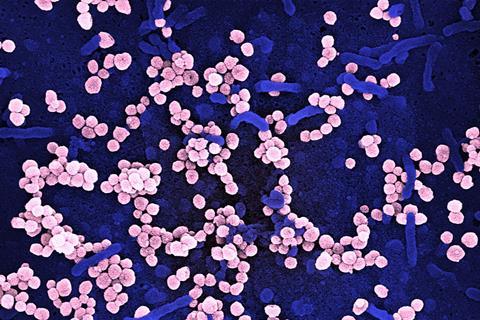After more than 20 years of research on arenaviruses, an Institut Pasteur team led by Sylvain Baize has developed an original vaccine platform known as MOPEVAC, which will strengthen the Institut Pasteur’s pandemic preparedness initiatives. A Phase Ia clinical trial led by a research team at the Institut Pasteur is set to begin for the platform’s first vaccine candidate, which targets Lassa fever, a hemorrhagic fever responsible for thousands of deaths worldwide each year.

In the long term, the MOPEVAC platform will enable scientists to respond to the emergence of new viruses with effective candidate vaccines aimed at pathogens with high mortality rates. The MOPEVAC clinical trials are funded by the France 2030 program as part of the “Emerging infectious diseases and CBRN threats” strategy. They are led by the French Health Innovation Agency and operated on behalf of the French government by Bpifrance, which also supported the preclinical trials.
READ MORE: ‘Unbreakable’ Lassa vaccine shows promising results
READ MORE: Researchers uncover genetic factors for severe Lassa fever
Lassa fever, caused by the Lassa arenavirus, claims between 5,000 and 6,000 lives in West Africa every year. The virus is contracted through exposure to the bodily fluids or feces of Natal multimammate mice (Mastomys natalensis) living near human populations. The disease is endemic in regions where the mice live, especially in Nigeria, the most affected country and the most populated country in Africa.
Given the lack of effective drugs, vaccination is the best strategy to tackle the disease. The team led by Sylvain Baize, Head of the Institut Pasteur’s Biology of Viral Emerging Infections Unit, therefore set out to develop an effective Lassa fever vaccine using attenuated viral vectors, with the help of the Institut Pasteur’s Bioinformatics Hub and the Inserm-Jean Mérieux BSL-4 laboratory.
Remote areas
“To obtain lasting, effective protection, we needed to work on a vector-based vaccine that could be administered in remote areas in countries with limited healthcare infrastructure, and which would ideally be effective with a single dose, as is the case for the yellow fever vaccine, for example. For hemorrhagic fevers like Lassa fever, live attenuated vectors are the best targets,” explains Sylvain Baize.
In 2003, Sylvain Baize’s team shifted its research focus to this approach after comparing Lassa virus with Mopeia virus, another virus in the same family which is similar to Lassa but not pathogenic for humans. The scientists used reverse genetics techniques to modify the Mopeia virus. They deleted an immunosuppressive domain in the viral genome and replaced part of its genetic material with the envelope glycoprotein sequence from the Lassa virus. Glycoproteins are involved in viral entry into the cell at the point of infection and therefore represent a major target for the immune system. In this way the team obtained a virus that was still capable of replicating and induced a specific immune reaction against Lassa virus. This is the vaccine candidate used in the Phase I clinical trial in connection with the MOPEVAC project.
Preclinical trials
Preclinical trials were performed on animal cells and models, and extensive toxicology studies are currently being carried out. The production process was transferred to a manufacturer and optimized, and this same manufacturer will be responsible for producing the vaccine batch used for the Phase I trial. The Institut Pasteur is sponsoring the trial, which will be conducted in collaboration with the Cochin-Pasteur Vaccinology Clinical Investigation Center led by Odile Launay.
“The Phase Ia clinical trial will involve 72 healthy volunteers. The vaccine’s safety and the immune responses it generates will be monitored in these subjects for more than a year. The first inclusion period should take place in early 2026,” explains the scientist.
Sylvain Baize’s team, with the support of the Institut Pasteur’s Technology Transfer and Industrial Partnership Department and Medical Department, is particularly well placed to organize and monitor this project as it has expertise in basic virology research, hemorrhagic fever pathophysiology in animals and humans, and also diagnostics. The laboratory serves as the National Reference Center for Viral Hemorrhagic Fevers and therefore carries out regular field work, for example during the 2014 Ebola epidemic.
Future epidemics
“We are involved at every stage: diagnosis, monitoring viral development with the description of new strains, and finally vaccine development. It is crucial that we monitor these viruses carefully and develop prevention and treatment strategies, as one of them may give rise to a future epidemic. Lassa hemorrhagic fever is the most frequently imported disease to Global North countries. This is a widespread public health problem and one that we need to prepare for by developing several different vaccine vector platforms,” emphasizes the scientist.
While awaiting the results of the Lassa fever vaccine candidate, the MOPEVAC platform has also been adapted to obtain a more universal expression vector that would enable scientists to respond to emerging viruses with effective vaccine candidates against other pathogens with very high mortality rates. The Mopeia virus glycoprotein gene can be replaced with any of the glycoprotein genes from viruses in the same family, arenaviruses. So the team has adapted the MOPEVAC platform to the five arenaviruses that circulate in South America and are dangerous for humans, and has developed a pentavalent vaccine for these pathogens.
Watch the video:
From lab to people, by Sylvain Baize [Fundamentally applied]







No comments yet